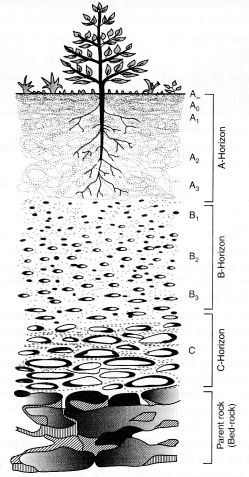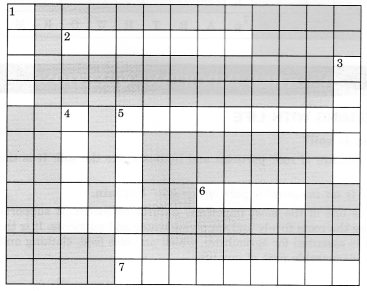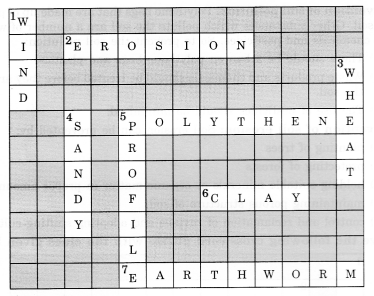NCERT Solutions for Class 7 Science Chapter 9 Soil are part of NCERT Solutions for Class 7 Science. Here we have given NCERT Solutions for Class 7 Science Chapter 9 Soil.
| Board | CBSE |
| Textbook | NCERT |
| Class | Class 7 |
| Subject | Science |
| Chapter | Chapter 9 |
| Chapter Name | Soil |
| Number of Questions Solved | 10 |
| Category | NCERT Solutions |
NCERT Solutions for Class 7 Science Chapter 9 Soil
Tick the most suitable answer in questions 1 and 2.
Question 1.
In addition to the rock particles, the soil contains
(i) air and water
(ii) water and plants
(iii) minerals, organic matter, air and water
(iv) water, air and plants
Answer:
(iii) minerals, organic matter, air and water
Question 2.
The water holding capacity is the highest in
(i) sandy soil
(ii) clayey soil
(iii) loamy soil
(iv) mixture of sand and loam
Answer:
(ii) clayey soil
Question 3.
Match the items in Column I with those in Column II :
| Column I | Column II |
| (i) A home for living organisms | (a) Large particles |
| (ii) Upper layer of the soil | (b) All kinds of soil |
| (iii) Sandy soil | (c) Dark in colour |
| (iv) Middle layer of the soil | (d) Small particles and packed tight |
| (v) Clayey soil | (e) Lesser amount of humus |
Answer:
| Column I | Column II |
| (i) A home for living organisms | (b) All kinds of soil |
| (ii) Upper layer of the soil | (c) Dark in colour |
| (iii) Sandy soil | (a) Large particles |
| (iv) Middle layer of the soil | (e) Lesser amount of humus |
| (v) Clayey soil | (d) Small particles and packed tight |
Question 4.
Explain how soil is formed?
Answer:
- The big and heavy rocks are broken into smaller pieces that come on the surface of the earth.
- Soil is formed by breaking down of rocks by the action of wind, water, and climate. This process is called weathering.
- The smaller particles of the rocks obtained due to weathering get further decomposed on long exposure to air and moisture.
- Finally, the decomposed parts of dead plants and animals get mixed up with soil formed by the above processes. This gives the soil enough energy in the form of organic matter.
Question 5.
How is clayey soil useful for crops?
Answer:
Clayey soil retains water to a great extent. Thus the crops which require more water grow well in clayey soil.
Question 6.
List the differences between clayey soil and sandy soil.
Answer:
| Clayey Soil | Sandy Soil |
| 1.Proportion of fine particles is large. | 1.Proportion of big particles is large. |
| 2. Has least percolation rate of water. | 2. Has largest percolation rate of water. |
| 3. Has good water holding capacity. | 3. Has poor water holding capacity. |
Question 7.
Sketch the cross-section of soil and label the various layers.
Answer:

Fig. A soil profile. Various horizontal zones indicate the stages in soil formation
Question 8.
Razia conducted an experiment in the field related to the rate of percolation. She observed that it took 40 min for 200 mL of water to percolate through the soil sample. Calculate the rate of percolation.
Answer:
Given, amount of water = 200 mL
Time taken = 40 min
Rate of percolation (mL/min) = \(\frac { Amount of water(mL) }{ Amount of water(mL) }\)
= \(\frac { 200 ml}{ 40 Min }\)
= 5 mL / min .
Question 9.
Explain, how soil pollution and soil erosion could be prevented.
Answer:
Prevention of soil pollution:
- There should be a ban on polythene bags and plastics.
- Waste products and chemicals should be treated before they are released into the soil.
- The use of pesticides should be minimized
Prevention of soil erosion:
- By growing trees.
- Avoid deforestation.
- Maintaining the porous structure of the soil.
- Control and reclamation of ravines and shifting of cultivation.
Question 10.
Solve the following crossword puzzle with the clues given below:

Across
2. Plantation prevents it.
5. Use should be banned to avoid soil pollution.
6. Type of soil used for making pottery.
7. Living organism in the soil.
Down
1. In desert, soil erosion occurs through.
3. Clay and loam are suitable for cereals like.
4. This type of soil can hold very little water.
5. Collective name for layers of soil.
Answer:

We hope the NCERT Solutions for Class 7 Science Chapter 9 Soil help you. If you have any query regarding NCERT Solutions for Class 7 Science Chapter 9 Soil, drop a comment below and we will get back to you at the earliest.